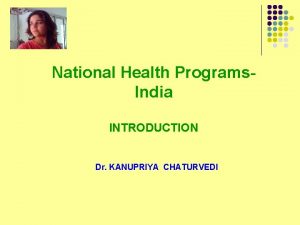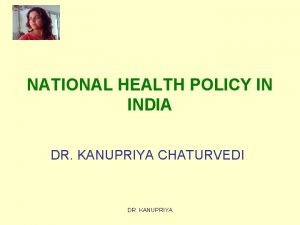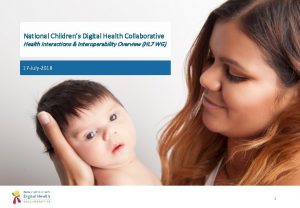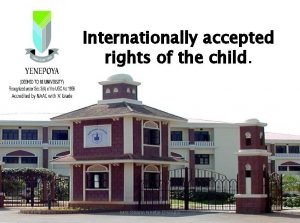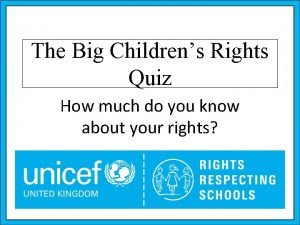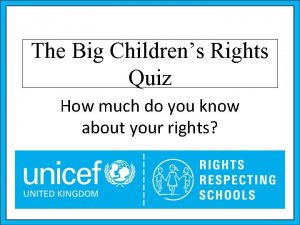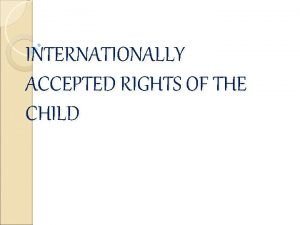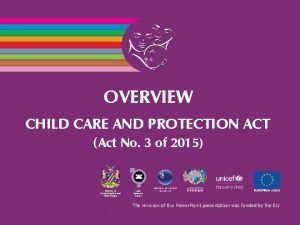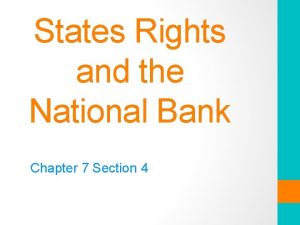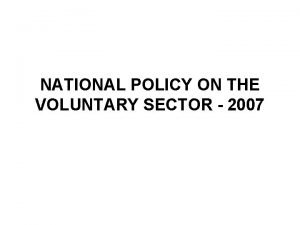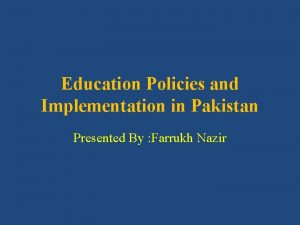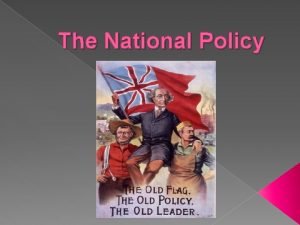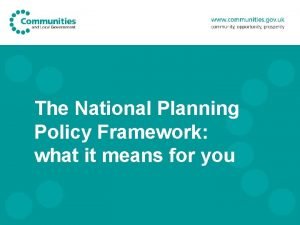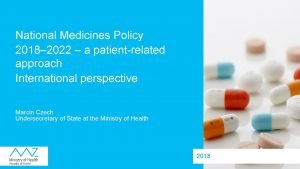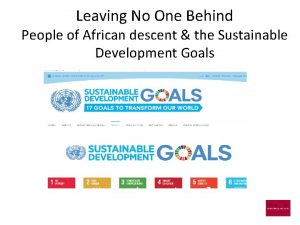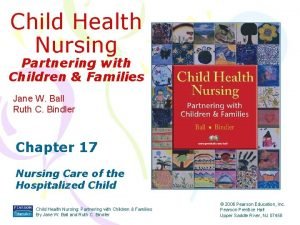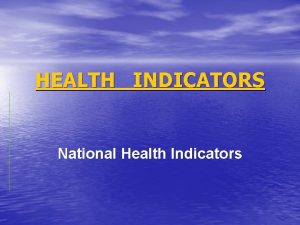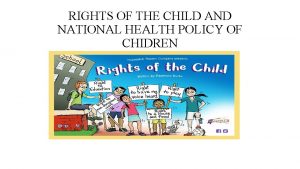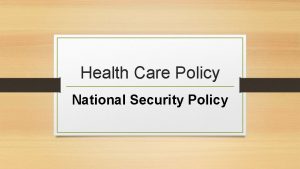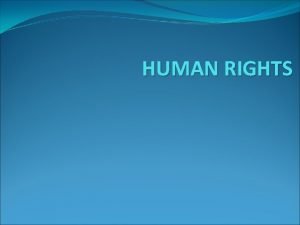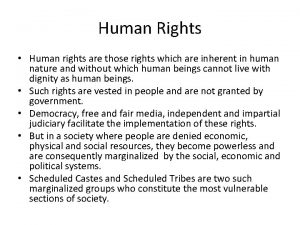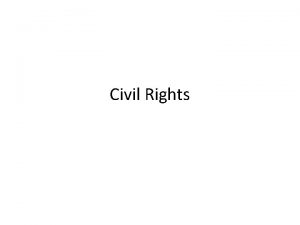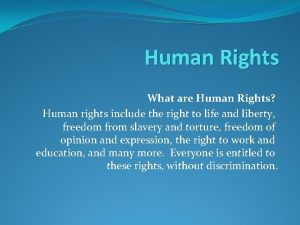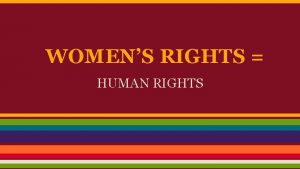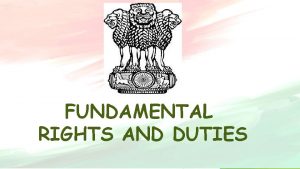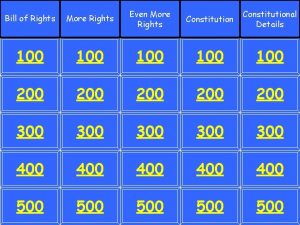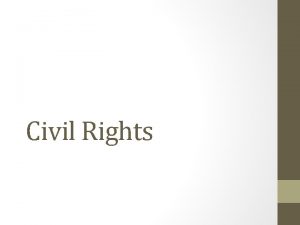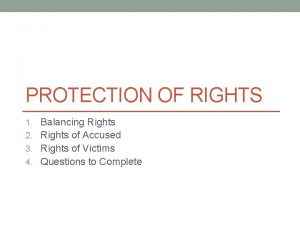RIGHTS OF CHILDREN NATIONAL HEALTH POLICY FOR CHILDREN



























![CONT…………… [B] Provide universal access to information and services for making informed choices related CONT…………… [B] Provide universal access to information and services for making informed choices related](https://slidetodoc.com/presentation_image_h2/7cee1ac51545e2bfd4417c418ef53232/image-28.jpg)
![Cont… [E] Encourage focused behavior change communication efforts to improve new born and childcare Cont… [E] Encourage focused behavior change communication efforts to improve new born and childcare](https://slidetodoc.com/presentation_image_h2/7cee1ac51545e2bfd4417c418ef53232/image-29.jpg)
![CONT…………. [H] Ensure availability of essential services, supports and provisions for nutritive attainment in CONT…………. [H] Ensure availability of essential services, supports and provisions for nutritive attainment in](https://slidetodoc.com/presentation_image_h2/7cee1ac51545e2bfd4417c418ef53232/image-30.jpg)
![Cont…………………. [K] Ensure that only child safe products and services are available in the Cont…………………. [K] Ensure that only child safe products and services are available in the](https://slidetodoc.com/presentation_image_h2/7cee1ac51545e2bfd4417c418ef53232/image-31.jpg)





















![� THE � CHILDREN ACT 1960[amended] : The children act 1960 (amended) in india � THE � CHILDREN ACT 1960[amended] : The children act 1960 (amended) in india](https://slidetodoc.com/presentation_image_h2/7cee1ac51545e2bfd4417c418ef53232/image-53.jpg)




- Slides: 57

RIGHTS OF CHILDREN, NATIONAL HEALTH POLICY FOR CHILDREN, SPECIAL LAWS and ordinances relating to children



INTRODUCTION: � The united nations adopted the “Declaration of the Rights of children” , on 20 th november, 1959, to meet the special needs of the child. � India was a signatory to this declaration to give the child pride of place and to make the people aware of the rights and needs of children and duties towards them.

Cared for:

CARED FOR: � All organizations concerned with children � All children have a right to a birth certificate. � Children should not be separated from their parents unless it is for their own good. � If parents decide to live apart, children have the right to stay in contact with both parents. � Families who live in different countries have the right to get back together and live in All over the world, children can be separated from the same place.

protection

PROTECTION: All children should be … � protected from violence, abuse and neglect, and governments should protect them. � Not allowed to do work that is dangerous or might make them ill, or stops them going to school. � Children have a right to be protected from dangerous drugs, and from the business of making or selling them. � Nobody can do anything to your body that you do not want them to do, and grown-ups should protect you. � No child should be punished in a way that humiliates Over 100 million children do dangerous work , often or hurts them.

participating

PARTICIPATING : � All children have a right to be able to give their opinion when adults are making a decision that will affect them, and adults should take it seriously. � All children have a right to find out things, and say what they think through speaking, writing, drawing etc. unless it breaks the rights of others. � All children have the right to meet, make friends with, and join clubs with other children. � All children have the right to privacy. � All children have the right to information from TV, radio, newspapers and the internet. These media should provide information that children can understand.

FREEDOME OF EXPRESSION: � All children have the right to think and believe what they want, and to practice their religion. � Parents should help children learn what is right and wrong. � Children who are refugees or asylum seekers in another land have the right to special protection. They have the same rights as children who were born in that country. � Children who come from a minority group have the right to learn and use the language and customs of their families. Also to practice their own religion and use their own language.

EDUCATION AND PLAY : � All children have the right to an education. � The purpose of education is to develop every child’s personality, talents and mental and physical abilities. � Education should teach children to respect their parents, their own and other cultures. � Education should prepare children to live responsibly and peacefully in a free society. � Education should teach children to respect the natural environment. � All children have the right to relax and play, and to join a wide range of activities.

SURVIVAL AND DEVELOPMENT: � Every child has the right to life. � Children who are disabled, either mentally or physically, have a right to special care and education so they can lead full and independent lives. � All children have a right to good health and good quality health care. All children should have clean water, nutritious food and a clean environment so they stay healthy. � All children have the right to a decent standard of living. The Government should help families who cannot afford to provide a decent standard of living for their children.

REHABILITATION AND CARE : � Children under the age of 16 years should not take a direct part in any conflict. A � Children who are affected by an armed conflict should have special protection and care. � Children who have suffered in any way have a right to get help in a safe place, to help them recover. Rehabilitation means that things are done to put life back to normal.

NATIONAL HEALTH POLICY FOR CHILDREN 2013:

INTRODUCTION � India is home to the largest child population in the world. The Constitution of India guarantees Fundamental Rights to all children in the country and empowers the State to make special provisions for children. The Directive Principles of State Policy specifically guide the State in securing the tender age of children from abuse and ensuring that children are given opportunities and facilities to develop in a healthy manner in conditions of freedom and dignity. The State is responsible for ensuring that childhood is protected from exploitation and moral and material abandonment.

CONT……………. . � The National Policy for Children, 1974 recognised that programmes for children should find prominent place in national plans for the development of human resources, so that children grow up to become robust citizens, physically fit, mentally alert and morally healthy, endowed with the skills and motivations provided by society. The Policy also laid emphasis on equal opportunities for the development of all children during the period of growth

PREAMLE � Recognising that: � - A child is any person below the age of eighteen years; � - Childhood is an integral part of life with a value of its own; � - Children are not a homogenous group and their different needs need different responses, especially the multi-dimensional vulnerabilities experienced by children in different circumstances; � - A long term, sustainable, multi-sectoral, integrated and inclusive approach is necessary for the overall and harmonious development and protection of children.

Reaffirming that: � � - Every child is unique and a supremely important national asset; - Special measures and affirmative action are required to diminish or eliminate conditions that cause discrimination, - All children have the right to grow in a family environment, in an atmosphere of happiness, love and understanding; - Families are to be supported by a strong social safety net in caring for and nurturing their children the Government of India reiterates its commitment to safeguard, inform, include, support and empower all children within its territory and jurisdiction, both in their individual situation and as a national asset. The State is committed to take affirmative measures – legislative, policy or otherwise – to promote and safeguard the right of all children to live and grow with equity, dignity, security and freedom, especially those marginalized or disadvantaged; to ensure that all children have equal opportunities; and that no custom, tradition, cultural or religious practice is allowed to violate or restrict or prevent children from enjoying their rights.

CONT………. . � This Policy is to guide and inform all laws, policies, plans and programmes affecting children. All actions and initiatives of the national, state and local government in all sectors must respect and uphold the principles and provisions of this Policy

GUIDING PRINCIPLES � (i) Every child has universal, inalienable and indivisible human rights � (ii) The rights of children are interrelated and interdependent, and each one of them is equally important and fundamental to the well-being and dignity of the child � (iii) every child has the right to life, survival, development, education, protection and participation � (iv) right to life, survival and development goes beyond the physical existence of the child and also encompasses the right to identity and nationality � (v) mental, emotional, cognitive, social and cultural development of the child is to be addressed in totality

Cont……………. . � (vi) all children have equal rights and no child shall be discriminated against on grounds of religion, race, caste, sex, place of birth, class, language, and disability, social, economic or any other status � (vii) the best interest of the child is a primary concern in all decisions and actions affecting the child, whether taken by legislative bodies, courts oflaw, administrative authorities, public, private, social, religious or � cultural institutions � (viii) family or family environment is most conducive for the all-round development of children and they are not to be separated from their parents, except where such separation is necessary in their best interest;

CONT…………. . � (ix) every child has the right to a dignified life, free from exploitation � (x) safety and security of all children is integral to their well-being and children are to be protected from all forms of harm, abuse, neglect, violence, maltreatment and exploitation in all settings including care institutions, schools, hospitals, crèches, families and communities � (xi) children are capable of forming views and must be provided a conducive environment and the opportunity to express their views in any way they are able to communicate, in matters affecting them

CONT…………. � (xii) children’s views, especially those of girls, children from disadvantaged groups and marginalized communities, are to be heard in all matters affecting them, in particular judicial and administrative proceedings and interactions, and their views given due consideration in accordance with their age, maturity and evolving capacities.

Key Priorities Survival, health, nutrition, development, education, protection and participation are the undeniable rights of every child and are the key priorities of this Policy

SURVIVAL , HEALTH, AND NUTRITION � The right to life, survival, health and nutrition is an inalienable right of every child and will receive the highest priority. q The State stands committed to ensure equitable access to comprehensive, � and essential, preventive, promotive, curative and rehabilitative health care, of the highest standard, for all children before, during and after birth, and throughout the period of their growth and development.

Cont… q Every child has a right to adequate nutrition and to be safeguarded against hunger, deprivation and malnutrition. The State commits to securing this right for all children through access, provision and promotion of required services and supports for holistic nurturing, wellbeing with nutritive attainment of all children, keeping in view their individual needs at different stages of life in a life cycle approach. q The State shall take all necessary measures to: [A] Improve maternal health care, including antenatal care, safe delivery by skilled health personnel, post natal care and nutritional support
![CONT B Provide universal access to information and services for making informed choices related CONT…………… [B] Provide universal access to information and services for making informed choices related](https://slidetodoc.com/presentation_image_h2/7cee1ac51545e2bfd4417c418ef53232/image-28.jpg)
CONT…………… [B] Provide universal access to information and services for making informed choices related to birth and spacing of children [C] Secure the right of the girl child to life, survival, health and nutrition [D] Address key causes and determinants of child mortality through interventions based on continuum of care, with emphasis on nutrition, safe drinking water sanitation and health education.
![Cont E Encourage focused behavior change communication efforts to improve new born and childcare Cont… [E] Encourage focused behavior change communication efforts to improve new born and childcare](https://slidetodoc.com/presentation_image_h2/7cee1ac51545e2bfd4417c418ef53232/image-29.jpg)
Cont… [E] Encourage focused behavior change communication efforts to improve new born and childcare practices at the household and community level. [F] Provide universal and affordable access to services for prevention, treatment, care and management of neo-natal and childhood illnesses and protect children from all water borne, vector borne, blood borne, communicable and other childhood diseases [G] Prevent disabilities, both mental and physical, through timely measures for pre-natal, peri-natal and post-natal health and nutrition care of mother and child, provide services for early detection, treatment and management, including interventions to minimize and prevent further disabilities, prevent discrimination faced by children with disabilities (mental and physical), and provide services for rehabilitation and social support
![CONT H Ensure availability of essential services supports and provisions for nutritive attainment in CONT…………. [H] Ensure availability of essential services, supports and provisions for nutritive attainment in](https://slidetodoc.com/presentation_image_h2/7cee1ac51545e2bfd4417c418ef53232/image-30.jpg)
CONT…………. [H] Ensure availability of essential services, supports and provisions for nutritive attainment in a life cycle approach, including infant and young child feeding (IYCF) practices, special focus on adolescent girls and other vulnerable groups, and special measures for the health, care and nutrition, including nutrition education, of expectant and nursing mothers [I] Provide adolescents access to information, support and services essential for their health and development, including information and support on appropriate life style and healthy choices and awareness on the ill effects of alcohol and substance abuse [J] Prevent HIV infections at birth and ensure infected children receive medical treatment, adequate nutrition and after-care, and are not discriminated against in accessing their rights.
![Cont K Ensure that only child safe products and services are available in the Cont…………………. [K] Ensure that only child safe products and services are available in the](https://slidetodoc.com/presentation_image_h2/7cee1ac51545e2bfd4417c418ef53232/image-31.jpg)
Cont…………………. [K] Ensure that only child safe products and services are available in the country and put in place mechanisms to enforce safety standards for products and services designed for children [L] Provide adequate safeguards and measures against false claims relating to growth, development and nutrition

EDUCATION AND DEVELOPMENT v Every child has equal right to learning, knowledge and education. The State recognizes its responsibility to secure this right for every child, with due regard for special needs, through access, provision and promotion of required environment, information, infrastructure, services and supports, towards the development of the child’s fullest potential. v The State shall take all necessary measures to: � Provide universal and equitable access to quality Early Childhood Care and Education (ECCE) for optimal development and active learning capacity of all children below six years of age

� Ensure that every child in the age group of 6 -14 years is in school and enjoys the fundamental right to education as enshrined in the Constitution � Promote affordable and accessible quality education up to the secondary level for all children. Foster and support inter sectoral networks and linkages to provide vocational training options including comprehensively addressing age specific and gender-specific issues of children’s’ career choices through career counseling and vocational guidance.

CONT……………… Foster and support inter sectoral networks and linkages to provide vocational training options including comprehensively addressing age specific and genderspecific issues of children’s’ career choices through career counseling and vocational guidance � Ensure that all out of school children such as child laborers, migrant children, trafficked children, children of migrant labour, street children, child victims of alcohol and substance abuse, children in areas of civil unrest, orphans, children with disability (mental and physical), children with chronic ailments, married children, children of manual scavengers, children of sex workers, children of prisoners, etc. are tracked, rescued, rehabilitated and have access to their right to education �

Cont………………. . � Address discrimination of all forms in schools and foster equal opportunity, treatment and participation irrespective of place of birth, sex, religion, disability, language, region, caste, health, social, economic or any other status � Prioritise education for disadvantaged groups by creating enabling environment through necessary legislative measures, policy and provisions � Ensure physical safety of the child and provide safe and secure learning environment � Ensure that all processes of teaching and learning are child friendly

CONT………………. Ensure formulation and practice of pedagogy that engages and delights children, with a special focus on mental health, from a social and gender just, life skills and age appropriate perspective � Provide access to ICT tools for equitable, inclusive and affordable education for all children especially in remote, tribal and hard to reach areas � Promote safe and enjoyable engagement of children’s experiences with new technology in accordance with their age and level of maturity, even as there is respect for their own culture and roots � Review, develop and sustain age-specific initiatives, services and programmes for safe spaces for play, sports, recreation, leisure, cultural and scientific activities for children in neighborhoods, schools and other institutions �

Cont………………. � � Enable children to develop holistically, bringing out their aspirations, with focus on their strengths, empowering them to take control of their lives, bodies and behaviors Ensure no child is subjected to any physical punishment or mental harassment. Promote positive engagement to impart discipline so as to provide children with a good learning experience Ensure that children’s health is regularly monitored through the school health programmed and arrangements are made for health and emergency care of children Provide services to children with special needs in regular schools and ensure that these are inclusive and have all facilities such as trained teachers and special educators, appropriate pedagogy and education material, barrier-free access for mobility, functional toilets and co curricular activities towards the development of child’s fullest potential and autonomy and sense of dignity and self worth

CONT………………… � � � Promote engagement of families and communities with schools for all round development of children, with emphasis on good health, hygiene and sanitation practices, including sensitization on ill-effects of alcohol and substance abuse. Facilitate concerted efforts by local governments, nongovernmental organizations/community based organizations to map gaps in availability of educational services, especially in backward, child labour intensive areas, areas of civil unrest, and in situations of emergency, and efforts for addressing them. Identify, encourage and assist gifted children, particularly those belonging to the disadvantaged groups, through special programmers. Provide and promote crèche and day care facilities for children of working mothers, mothers belonging to poor families, ailing mothers and single parents. Promote appropriate baby feeding facilities in public places and at workplaces for working mothers in public, private and unorganized sector.

PROTECTION A safe, secure and protective environment is a precondition for the realization of all other rights of children. Children have the right to be protected wherever they are. � The State shall create a caring, protective and safe environment for all children, to reduce their vulnerability in all situations and to keep them safe at all places, especially public spaces. � The State shall protect all children from all forms of violence and abuse, harm, neglect, stigma, discrimination, deprivation, exploitation including economic exploitation and sexual exploitation, abandonment, separation, abduction, sale or trafficking for any purpose or in any form, pornography, alcohol and substance abuse, or any other activity that takes undue advantage of them, or harms their personhood or affects their development �

CONT…………………. � � To secure the rights of children temporarily or permanently deprived of parental care, the State shall endeavour to ensure family and communitybased care arrangements including sponsorship, kinship, foster care and adoption, with institutionalization as a measure of last resort, with due regard to the best interests of the child and guaranteeing quality standards of care and protection. The State commits to taking special protection measures to secure the right sand entitlements of children in need of special protection, characterized by their specific social, economic and geo-political situations, including their need for rehabilitation and reintegration, n 0 n particular but not limited to, children affected by migration, displacement, communal or sectarian violence, civil unrest, disasters and calamities, street children, children of sex workers, children forced into commercial sexual exploitation, abused and exploited children, children forced into begging, children in conflict and contact with the law, children in situations of labour, children of prisoners, children infected/affected by HIV/AIDS, children with disabilities, children affected by alcohol and substance abuse, children of manual scavengers and children from any other socially excluded group, children affected by armed conflict and any other category of children requiring care and protection

CONT…………. � The State shall promote child friendly jurisprudence, enact progressive legislation, build a preventive and responsive child protection system, including emergency outreach services, and promote effective enforcement of punitive legislative and administrative measures against all forms of child abuse and neglect to comprehensively address issues related to child protection. � The State shall promote and strengthen legislative, administrative and institutional redressal mechanisms at the National and State level for the protection of child rights. For local grievances, effective and accessible grievance redressed mechanisms shall be developed at the programmed level

PARTICIPATION � � � The State has the primary responsibility to ensure that children are made aware of their rights, and provided with an enabling environment, opportunities and support to develop skills, to form aspirations and express their views in accordance with their age, level of maturity and evolving capacities, so as to enable them to be actively involved in their own development and in all matters concerning and affecting them. The State shall promote and strengthen respect for the views of the child, especially those of the girl child, children with disabilities and of children from minority groups or marginalized communities, within the family; community; schools and institutions; different levels of governance; as well as in judicial and administrative proceedings that concern them. The State shall engage all stakeholders in developing mechanisms for children to share their grievances without fear in all settings; monitor effective implementation of children’s participation through monitor able indicators; develop different models of child participation; and undertake research and documentation of best practices

ADVOCACY AND PARTNERSHIPS � � � The State shall encourage the active involvement, participation and collective action of stakeholders such as individuals, families, local communities, nongovernmental organizations, civil society organizations, media and private sector including government in securing the rights of the child. The State shall make planned, coordinated and concerted efforts to raise public awareness on child rights and entitlements amongst the parents and caregivers/guardians as well as functionaries and duty bearers. All stakeholders are to promote the use of rights-based and equity-focused strategies, platforms, programmes, communications and other tools to generate awareness on child rights and the commitment to their achievement. This Policy is to be given wide publicity and supported by focused advocacy measures to ensure that children’s best interests and rights are accorded the highest priority in areas of policy, planning, resource allocation, governance, monitoring and evaluation, and children’s voices and views are heard in all matters and actions which impact their lives

CONT …………. � The State shall ensure that service delivery and justice delivery mechanisms and structures are participatory, responsive and child-sensitive, thereby enhancing transparency and ensuring public accountability. Synergistic linkages will be created with other progressive and successful experiments to learn from best practices across regions

COORDINATION , ACTION AND MONITORING � Addressing the rights and needs of children requires programming across different sectors and integrating their impact on the child in a synergistic way. Rights based approach to survival, development and protection calls for conscious, convergent and collateral linkages among different sectors and settings, with indicators for tracking progress � Community and local governance play a significant role in ensuring the child’s optimum development and social integration. Ensuring coordination among Central Government Ministries/Departments, between Central and State Governments, between different levels of governance and between government and civil society is crucial for effective implementation of this Policy.

Cont…………. The Ministry of Women and Child Development (MWCD) will be the nodal Ministry for overseeing and coordinating the implementation of this Policy. A National Coordination and Action Group (NCAG) for Children under the Minister in charge of the Ministry of Women and Child Development will monitor the progress with other concerned Ministries as its members. Similar Coordination and Actions Groups will be formed at the State and District level. � The Ministry of Women and Child Development, in consultation with all related Ministries and Departments, will formulate a National Plan of Action for Children. Similar Plans at the State, District and local level will be formulated to ensure action on the provisions of this Policy. The National, State and District Coordination and Action Groups will monitor the progress of implementation under these Plans. �

Cont………………. . The Ministry of Women and Child Development (MWCD) will be the nodal Ministry for overseeing and coordinating the implementation of this Policy. A National Coordination and Action Group (NCAG) for Children under the Minister in charge of the Ministry of Women and Child Development will monitor the progress with other concerned Ministries as its members. Similar Coordination and Actions Groups will be formed at the State and District level. � The Ministry of Women and Child Development, in consultation with all related Ministries and Departments, will formulate a National Plan of Action for Children. Similar Plans at the State, District and local level will be formulated to ensure action on the provisions of this Policy. The National, State and District Coordination and Action Groups will monitor the progress of implementation under these Plans. �

RESEARCH, DOCUMENTATION AND CAPACITY BUILDING � Addressing the rights and needs of children requires programming across different sectors and integrating their impact on the child in a synergistic way. Rights based approach to survival, development and protection calls for conscious, convergent and collateral linkages among different sectors and settings, with indicators for tracking progress � Community and local governance play a significant role in ensuring the child’s optimum development and social integration. Ensuring coordination among Central Government Ministries/Departments, between Central and State Governments, between different levels of governance and between government and civil society is crucial for effective implementation of this Policy.

Cont……………… � The Ministry of Women and Child Development (MWCD) will be the nodal Ministry for overseeing and coordinating the implementation of this Policy. A National Coordination and Action Group (NCAG) for Children under the Minister in charge of the Ministry of Women and Child Development will monitor the progress with other concerned Ministries as its members. Similar Coordination and Actions Groups will be formed at the State and District level

RESOURCE ALLOCATION � The State commits to allocate the required financial, material and human resources, and their efficient and effective use, with transparency and accountability, to implement this Policy. � Child budgeting will track allocation and utilization of resources and their impact on outcomes for children with regard to budgets and expenditures on children by all related Ministries and Departments

REVIEW OF POLICY �A comprehensive review of this Policy will be taken up once in five years in consultation with all stakeholders, including children. The Ministry of Women and Child Development will lead the review process.

SPECIAL LAWS FOR CHILDREN � Labor (Prohibition & Regulation) Act, 1986 � Child Marriage Restraint Act, 1929 � Children Act, 1960 � Children (Pledging of Labor) Act, 1933 � Commissions for the Protection of Child Rights Act, 2005 � Commissions for Protection of Child Rights (Amendment) Act, 2006 � Infant Milk Substitutes Act, 1992 � Infant Milk Substitutes Act, 2003 � Infant Milk Substitutes, Feeding Bottles & Infant Foods (Regulation of Production, Supply & Distribution) Act, 1992 � Infant Milk Substitutes, Feeding Bottles & Infant Foods (Regulation of Production, Supply & Distribution) Amendment Act, 2003 � Juvenile Justice (Care & Protection of Children) Act, 1986 � Prohibition of Child Marriage Act, 2006 � Reformatory Schools Act, 1897 � Young Persons (Harmful Publications) Act, 1956
![THE CHILDREN ACT 1960amended The children act 1960 amended in india � THE � CHILDREN ACT 1960[amended] : The children act 1960 (amended) in india](https://slidetodoc.com/presentation_image_h2/7cee1ac51545e2bfd4417c418ef53232/image-53.jpg)
� THE � CHILDREN ACT 1960[amended] : The children act 1960 (amended) in india , provides for the care maintenance, walfare, training, education , and rehabilitatiom of the delinquent child. It covers the neglected , destitute, socially handicapped, uncontrollable, victimised and delinquent child. It covers the neglected, destitute, socially handicapped, uncontrollable , victimised and delinquent children. In Article 39 (f) , the constitution of india provides that “the state shall in particular direct its policy towards securing that childhood and youth are protected against moral and material abandonment”.

� JUVENILE � The JUSTICE ACT 1986 : juvenile justice Act , 1986, provides a comprehensive scheme for care , protection , treatment , development and rehabilitation of delinquent juveniles. The new Act has come in to force from 2 nd October 1987, after rectification of the inadequacies of the children Act (1960).

� THE CHILD LABOR ( PROTECTION AND REGULATION ) ACT 1986 : � The child labor protection and regulation Act , 1986 , provides guidelines about the restriction related to child labor. The supreme court of india , in 1996 , directed all state govt. and union territories for setting up of child labor rehabilitation welfare fund. Elimination of child labor can only be possible with combined effort of parent , community , govt. , non-govt. and voluntary agencies. creation of awareness about the evil is the prime responsibility to prevent and abolish it

CHILD MARRIAGE � defines child marriage as a formal marriage or union before 18 years of age. [] UN Women defines child marriage as a forced marriage before 18 years of age because they believe children under age 18 are incapable of giving their consent. [5] � Children in Scotland can marry at 16 without any parental consent. Scotland is the only developed country where child marriage is CHILD MARRIAGE ACT

� THANK YOU
 Child rights act 2005 images
Child rights act 2005 images National policy and legislation
National policy and legislation National health policy 2002
National health policy 2002 Dr. kanupriya chaturvedi
Dr. kanupriya chaturvedi National child health program
National child health program National children's digital health collaborative
National children's digital health collaborative Negative rights vs positive rights
Negative rights vs positive rights Littoral real estate
Littoral real estate Characteristics of rights
Characteristics of rights Legal rights and moral rights
Legal rights and moral rights What is negative right
What is negative right Negative right
Negative right Positive vs negative rights
Positive vs negative rights Negative right
Negative right Internationally accepted rights of the child
Internationally accepted rights of the child Children's rights quiz
Children's rights quiz Children's rights and responsibilities quiz
Children's rights and responsibilities quiz Internationally accepted rights of child
Internationally accepted rights of child Children's rights and responsibilities posters
Children's rights and responsibilities posters Chapter 7 section 4 states rights and the national bank
Chapter 7 section 4 states rights and the national bank Objective of zoo
Objective of zoo National policy on the voluntary sector 2007
National policy on the voluntary sector 2007 National education policy 1998 to 2010 in pakistan
National education policy 1998 to 2010 in pakistan The national policy
The national policy What is national planning policy framework
What is national planning policy framework National medicines policy
National medicines policy Conclusion of learning without burden
Conclusion of learning without burden A national policy of avoiding involvement in world affairs
A national policy of avoiding involvement in world affairs Health is human rights
Health is human rights Parental rights over child's health
Parental rights over child's health Fspos vägledning för kontinuitetshantering
Fspos vägledning för kontinuitetshantering Typiska drag för en novell
Typiska drag för en novell Tack för att ni lyssnade bild
Tack för att ni lyssnade bild Returpilarna
Returpilarna Varför kallas perioden 1918-1939 för mellankrigstiden?
Varför kallas perioden 1918-1939 för mellankrigstiden? En lathund för arbete med kontinuitetshantering
En lathund för arbete med kontinuitetshantering Adressändring ideell förening
Adressändring ideell förening Personlig tidbok för yrkesförare
Personlig tidbok för yrkesförare Anatomi organ reproduksi
Anatomi organ reproduksi Densitet vatten
Densitet vatten Datorkunskap för nybörjare
Datorkunskap för nybörjare Tack för att ni lyssnade bild
Tack för att ni lyssnade bild Debatt artikel mall
Debatt artikel mall För och nackdelar med firo
För och nackdelar med firo Nyckelkompetenser för livslångt lärande
Nyckelkompetenser för livslångt lärande Påbyggnader för flakfordon
Påbyggnader för flakfordon Kraft per area
Kraft per area Svenskt ramverk för digital samverkan
Svenskt ramverk för digital samverkan Kyssande vind analys
Kyssande vind analys Presentera för publik crossboss
Presentera för publik crossboss Vad är ett minoritetsspråk
Vad är ett minoritetsspråk Bat mitza
Bat mitza Klassificeringsstruktur för kommunala verksamheter
Klassificeringsstruktur för kommunala verksamheter Luftstrupen för medicinare
Luftstrupen för medicinare Claes martinsson
Claes martinsson Centrum för kunskap och säkerhet
Centrum för kunskap och säkerhet Lågenergihus nyproduktion
Lågenergihus nyproduktion Bra mat för unga idrottare
Bra mat för unga idrottare


